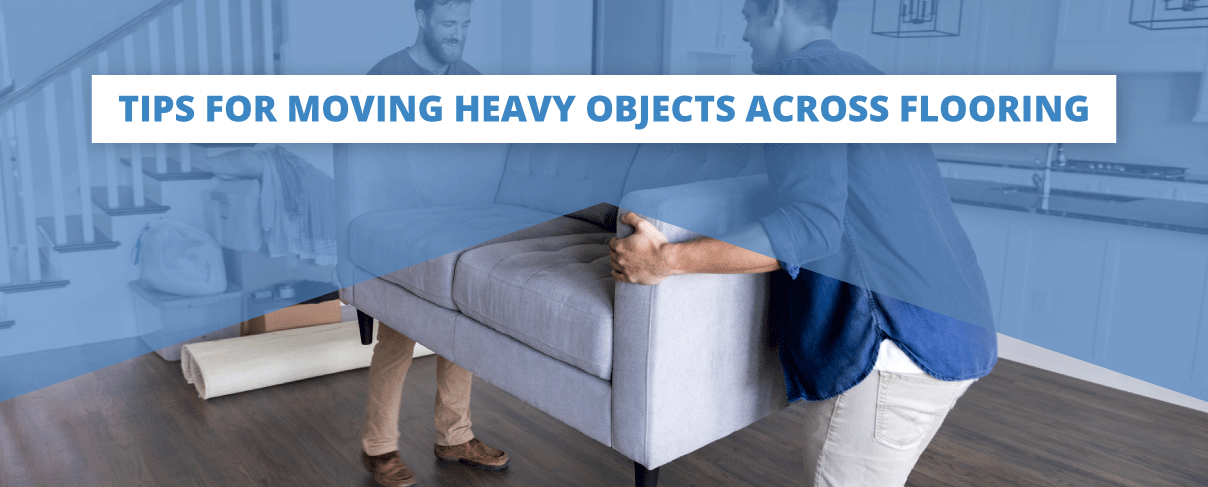

Whether you are moving into a home, rearranging your furniture for spring cleaning or just bringing in a new sofa, sometimes you need to move heavy objects across floors. Unfortunately, this is where your flooring is most vulnerable.
Knowing how to move heavy furniture without scratching the floor is essential. Dropping large furniture or other items on your wood floors can leave dings and dents. Dragging heavy items can create deep gouges or scratches that can ruin the look of your whole room. Even on carpet, moving heavy items can be a challenge. It can eventually cause the carpet’s backing to break and make the carpet wrinkle to the point it no longer lays flat. In some instances, moving heavy furniture may also cause rips or tears in the carpet. Follow these tips for how to move heavy furniture to preserve all types of flooring in your home.
How to Move Heavy Objects Without Damaging Your Floors
Moving large furniture on wood floors or carpets can be challenging. If you have to move a baby grand piano, boxes, bookshelves, couches or any heavy item, there are a few ways you can protect your floors.
1. Measure First
Prepare for moving day by measuring your furniture and doorways to make sure that every item will fit. Trying to squeeze an object into a room when it’s too large for the opening can cause you to drop things. Planning ahead can prevent last-minute maneuvering that can lead to damaged floors. If you measure first, moving day will run smoother with fewer accidents.
2. Prepare Your Space
Always sweep your hard surface floors or vacuum your carpets before you start to move anything. If there are any small bits of gravel or debris on the floor, placing heavy objects on them or moving items across them can cause gouges and scratches.
Similarly, make sure you are wearing indoor shoes when you move heavy items. Any dirt you bring into the house during the move can cause damage. Professional movers place disposable booties over their shoes for just this reason.
Remove any obstacles in the way to avoid bumping into or tripping over these items. Keep pets and children well out of the way on moving day.
3. Lift Where Possible
If it’s at all possible, lift an object and carry it to its place. Dragging furniture across the floor increases your chances of causing floor damage.
Remove any excess weight so that items are easier to carry. If you are moving a bookshelf, for example, take out the books and carry them separately. Before carrying a hutch of drawers, remove the drawers and anything inside the furniture item so it’s light enough to lift.
For items that are too large to manage by yourself, you can hire a professional mover or recruit a friend to help you move heavy items.
4. Take Furniture Apart
Disassemble any furniture that can come apart. Moving large objects will be much easier and safer for your floors if you can carry individual pieces instead of the entire item. They will also stack more neatly, so you can fit more into a moving truck.
Keep your toolbox handy to remove legs and other parts that are screwed into place. Store fasteners and other small parts in a labeled container so you can put everything back together in your new space.
5. Put Down Padding
If you must drag heavy items across the floor, put down padding such as towels or special moving blankets to protect your floors. Make sure there is no debris on this padding, as it will cause scratches. Also, never use paper-based padding such as cardboard, as it can scuff hard surface floors.
If you need to move furniture on carpet, you might consider adding furniture sliders directly underneath your heavy objects. The sliders have padding on top and a hard surface on the bottom to grip your furniture and help it glide smoothly across the floor. Placing sliders under the legs or corners can help you move items with ease and without causing damage to your carpet.
6. Use a Dolly
Take advantage of tools that can make moving easier and less damaging to your floors. Rather than carrying an object by hand, you can simply secure it onto a dolly and wheel it to another location. Dollies are especially useful when moving bulky appliances like a refrigerator or washing machine. A dolly can save time and potentially your back from heavy lifting.
If you’re moving heavy furniture on wood floors, make sure your dolly has inflatable rubber wheels. Solid rubber wheels can scratch hard surfaces, so the softer inflatable version is the best option.
7. Switch Sides
Furniture often comes in oblong shapes and sizes. If you can, try turning your furniture on its side or upside down. Switching sides can help your furniture fit through the door, make it easier to handle and distribute the weight better so it’s less likely to harm the floor. Turning an item can also make room for more hands to help carry the load.
8. Slow Down
When moving, work methodically. Rushing the job can lead to unnecessary accidents. Check to make sure your heavy objects have not slipped off the padding and you are not causing any damage to the floors as you work. Try several methods until you figure out how to move your furniture safely.
Call 50Floor to Replace Your Scuffed or Damaged Floor
Sometimes, even when you take all precautions, you end up scratching or otherwise damaging your floor. Or perhaps you have moved into a home where the previous owners have ruined the floors with improper care. Finding a repair service with high-quality craftsmanship for an affordable rate can be challenging.
Fortunately, there is a budget-conscious solution. 50Floor can come to your home and show you a range of quality, brand-name flooring solutions at great prices. Our warranties and professional services ensure your floors look amazing again in no time! Schedule your free, in-home consultation with 50Floor today.



